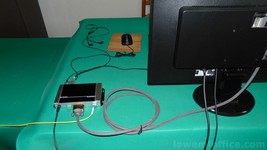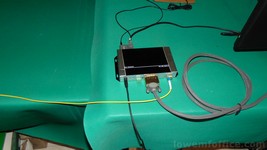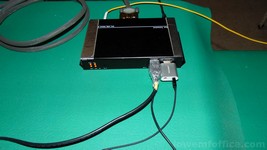Review of a fiber optic KVM extender
Introduction
This is the first product that we successfully use to have a complete connection of our desk to the computer, with a digital video channel of the needed resolution, channel for keyboard and mouse, channel for audio input and output. Actually this product exceeds our needs as it provides a full USB channel that supports also other small USB peripherals, like USB sound cards, and USB memory sticks.
Like all fiber optic KVM extenders, this product is composed of two separate devices, the Transmitter and the Receiver, connected by a fiber optic cable. The Transmitter is placed close to the computer and is connected to the computer by regular video, USB and audio cables. The Receiver is placed on the desk with the monitor, keyboard, mouse, and audio peripherals connected to it. Since the Transmitter is placed far away from the user, the problems may come from the Receiver, so in this article we speak almost only about the Receiver.
Fiber optic cable
The fiber optic cable required by this device is a single core, single mode, with LC connectors. These cables are available from many vendors online, and are inexpensive. We used a 20 m cable and which cost just about 5 EUR, and it worked smoothly. Let's remember that fiber optic connectors are sensitive to dust, so whenever the connector has to be detached we should put its cap on immediately. Also the fiber optic connector of the device might be obstructed by a speck of dust, so we should put the cap also on it. This fiber optic cable is very light and flexible, it can be easily installed in a PVC guide attached on the walls. It passes through a small hole of about 1 cm diameter. Let's just remember that the radius of curvature must not be too small, or the fiber optic could be damaged irreversibly, and also this cable can be destroyed by a source of heat, like an incandescent lamp, or a hot water pipe, so we have to check the route of the cable carefully. Anyway, having just one thin plastic cable with no electromagnetic emissions at all is a great result.
The fiber optic connectors of the device are standard SFP modules that can be replaced. The manufacturer and vendor also allows to choose between some different modules which use multi-mode fiber optic, or single-mode fiber optic.
DVI function
The DVI function of this product worked very well, we didn't have any problem. This product is made for a 4K video signal, but we have tried it so far with the 1920x1080@60 Hz resolution only. Perhaps if the monitor is capable of a higher resolution the product has some problems but we haven't tried it yet, and we can't say nothing about the higher resolutions yet.
USB function
The USB channel provided by this system works pretty well. We have connected a keyboard, a mouse, a USB sound device, and a USB memory stick. Everything worked fine. There has been no loss of signal during the insertion of the USB memory stick, the mouse and the keyboard never stopped working. The USB sound device works normally. Of course this is not a USB 3.0 channel, so the data transfer speed is still limited, but it is still useful to copy files on a USB memory stick without having to go to the computer side. We still haven't tried this system with a USB 3.0 external hard drive, but we don't recommend that, because a USB 3.0 hard drive has a lot of high frequency EMF, so it should not be kept on the desk in front of ourselves. Also the USB 3.0 frequency seems to introduce more EMF into the whole box, and in the DVI cable too, so it is better to avoid it. But the keyboard, mouse, audio and small USB memory stick can be used.
Heat
The Receiver doesn't heat up appreciably. We have noticed just a little warmth near the USB connectors, during the day, but it is not really hot. So probably this device can be used also in rooms where the ambient temperature goes up to 30°C or more during the summer.
Look
The exterior look of the Receiver is not bad. The USB ports ar on one side
while the DVI, audio, fiber optic and DC power connectors are on the other side.
It would be better if the audio connectors were on the side of the USB ports, so
the wires of the ear phones and the microphone wouldn't have to turn around the
box. This can be a problem if the audio wires pass close to the DC cable, or
close to the DVI cable.
Another little issue is the red lights on the USB side, they are very bright,
they would be more relaxing if they were green, also two of these lights are
blinking during the normal state, and this is a little distracting, such that we
prefer to hide these lights with a object placed in front of them.
According to the product description, the side with the red lights and the USB ports is called the back side, while the side with the DVI and fiber optic connectors is called the front side. But when this product is used on a desk, like we recommend, it is better to turn the side with the DVI and fiber optic module away from the user, because the EM emissions are surely higher from that side. Also, having the USB ports towards the user is better for the layout of the USB cables of the keyboard and the mouse. The USB ports seem to have negligible EM emissions.
Audio channel
This product contains also a bidirectional audio channel. Both the TX and the RX boxes have two audio connectors, labeled Audio In and Audio Out. The TX Audio In has to be connected to the Audio Out port of the computer (green) with a stereo audio cable with male plugs at both ends. Then at the desk side we can connect a headphones set or a set of speakers to the RX Audio Out. The analong sound signal comes from the computer's sound card and gets sampled and converted into a digital stream which is transmitted through the fiber optic cable. The RX turns the digital stream into analog sound that goes to the headphones or speakers.
This function works but there is a big problem of hum or buzz. We hear a very loud buzz in the headphones connected to the RX. This buzz is not caused by the audio cable at the TX side, or at least the audio cable at the TX side doesn't contrubute much, because if the audio cable at the TX side is removed the buzz in the headphones remains. So it seems that this buzz is generated by the circuit board of the Receiver.
We also noticed that the buzz changes in volume and in tone when the picture on the monitor changes, so it seems that this buzz is due to the electromagnetic noise of the monitor. We tried to move the Receiver far from the monitor by means of a longer DVI cable but the buzz remained the same, so probably the Receiver board gets the buzz from the DVI cable connected to the monitor.
This buzz is really too loud to be accepted, if we are listening at some music at loud volume then the buzz is almost unnoticeable, but as soon as the sound from the computer stops or becomes low, the buzz returns. So until this part of the product is improved, the analog audio channel is unusable.
Solution for the audio channel
This product supports an alternative solution for the audio channel. We can connect a small USB sound card to one of the USB ports of the Receiver and get the sound from the computer through the USB channel. This system works well and the sound quality is acceptable, there is no hum or buzz. There is no hum because the USB sound card gets the digital sound from the computer and then it generates the analog signal for the headphones.
The external USB sound card can be another source of high frequency EMF so we recommend to cover the body of the USB sound card with aluminum tape. There are also some small USB sound cards with a aluminum enclosure, at least on some sides.
This system can also be used for audio input, connecting a simple microphone to the USB sound card. If we have a headphone set that has also a microphone, and has only one audio plug with 4 contacts, we need a speaker-microphone splitter cable, that is available in the market.
DC power
This device requires 12 V DC. The original power adapter is rated for 1 A but surely the Receiver doesn't burn 12 W of power, otherwise it would become sensibly hot. We haven't measured the DC current absorbed by the Receiver, but we suspect that it is noticeably lower than 1 A. Also, the current absorbed by the receiver surely varies depending on the number of USB devices connected to is, and their power.
The original power adapter, like all these power adapters, creates a huge amount of EMF, we tried it for a few minutes just to see, and we felt the EMF immediately. So in practice the power adapter can't be used, at least at the desk side. We need a linear power supply to power the Receiver box.
The linear power supply of our modified LCD monitor has a 12 V DC 0.75 A output that can be used for this. Unfortunately, we designed this circuit to power a LED desk lamp, and if it is used for the Receiver box, it can't be used for the LED lamp for two reasons: first because the power absorbed would be too much, and second because the Receiver box would pass high frequency noise to the LED lamp, and this would be serious problem.
So at this moment we can't use the 12 V output of our power supply for a LED lamp, we are using it for the KVM Receiver box. Our power supply has also a 5V output which maybe could be used for a particular LED lamp.
Computer side
At the computer side the TX box is connected to the computer by means of a DVI cable and a USB cable, the audio channel is unusable as explained, so we don't keep the audio cable connected. The USB cable has male USB A plugs at both ends. The product came with a USB cable but we had problems with that cable. The mouse and the keyboard were freezing often, and also the USB audio was often interrupted. The video instead was working well. So we suspected that it was a problem of the USB connection at the computer side. We tried with another USB cable and the problem stopped. We tried again with the first USB cable and the problem happened again. The other USB cable that we tried has more shielding, so we suspect that the first USB cable was getting too much electromagnetic noise from the surroundings, so the USB signal between the computer and the TX box was corrupted. So it seems that for working correctly the USB cable at the computer side needs to be of good quality, with more shielding, and possibly also shorter. The USB cable provided with the product is thin, so it probably has less shielding inside, and it is also longer so it gets more EM noise. USB cables with more shielding can be found on many vendors.
EM emissions
The Receiver box is made of very thin steel or probably an aluminum alloy. It seems that there are no other holes, except the holes for the connectors, and two series of slots on the sides.
Initially we noticed an increase of the EMF on our desk, so we covered these slots with two layers of good quality aluminum tape. However, after trying the product for some days, and removing the EMF of the power adapter and checking other things, we suspect that the EMF emitted by these slots is negligible. Anyway, the aluminum tape is applied on a layer of masking tape, so we can remove it easily without damaging the product.
With this additional shielding and all the other precautions, the EMF of the Receiver seems to be low enough.
We have noticed an increase of the EMF of the whole desk when we tried to use a USB 3.0 hub attached to the Receiver. Also we had an impression of more EMF when we connected a USB memory stick to the Receiver. So we recommend to use the Receiver for the keyboard, mouse and audio only, and remove the other USB peripherals, connecting them just for the short time necessary.
Other applications
The USB channel of this product supports also most USB barcode scanners so we can, for example, have a barcode scanner on the desk, while the computer is placed well far away.
If four USB ports at the desk side are not enough, we can connect another USB hub to one of the KVM ports, and ghet more USB ports, but of copurse the USB hub and it USB cable, may have some high frequency electromagnetic emissions which can be a serious problem for the user. However not every USB hub works with this product.
Price and warranty
This product is currently sold at about 250 USD. The warranty on this product is 3 years by the manufacturer which is also the vendor.
Where to order
The manufacturer company has a website but we can't find the product ZY-OKD501 in the search box, however a Google search gave the following web page:
https://www.orivision.com.cn/4k-dvi-kvm-extender-with-fiber-optic-p00097p1.html
We bought this product through the Aliexpress online shop of this company, the web page is:
https://www.aliexpress.com/item/33050261132.html
The product is also available on Alibaba at the following page, the price seems to be the same:
https://www.alibaba.com/product-detail/4K-30hz-DVI-to-LC-SFP_62186301617.html
The fiber optic cable has to be bought separately, there are many offers of such cables on Ebay, Aliexpress and Alibaba, of different length. The fiber optic cable 20 m long should cost 5 - 10 USD plus shipping. The only problem with these vendors is that the shipping takes much time, it can take up to two months.
Shipping and customs duties
The shipping cost of course depends on the destination. The manufacturer is located in Nantong, China, close to Shangai, but we received the product from a sender from Hong Kong. The customs duties also vary from country to country. In some countries there is also VAT. When the shipping is done by a company that does also a service for the passage of the parcel through the customs, there is also a fee of the carrier.
Conclusions
In conclusion this product has some whims but it's a viable product for a Low EMF Office.
Summary
| Manufacturer and distributor | Orivision |
| Manufacturer country | China |
| Manufacturer web site | orivision.com.cn |
| Model | ZY-OKD501 |
| Company name | Nantong Zeal Young Electronic Co Ltd |
| Company place | Nantong Jiangsu (Shangai) |
| Fiber optic connector type | LC |







